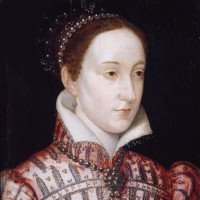Mary Queen of Scots is also known as Mary Stuart and is perhaps the most famous and intriguing of Scotland’s monarchs. Mary has many associations with the Trossachs area.
 As a child, Mary was crowned Queen at Stirling Castle in 1543 as her father King James V of Scotland died when she was 6 days old. Too young to reign, Scotland was ruled by Mary’s mother, Mary of Guise. Mary was sent for safety to Inchmahome Priory, which is situated on an island in the Lake of Menteith. The English King Henry VIII had tried to kidnap Mary to ensure that she married his son Edward when she was old enough. However an alliance with France was made by Mary’s mother and she was sent to France when she was 5 years old.
As a child, Mary was crowned Queen at Stirling Castle in 1543 as her father King James V of Scotland died when she was 6 days old. Too young to reign, Scotland was ruled by Mary’s mother, Mary of Guise. Mary was sent for safety to Inchmahome Priory, which is situated on an island in the Lake of Menteith. The English King Henry VIII had tried to kidnap Mary to ensure that she married his son Edward when she was old enough. However an alliance with France was made by Mary’s mother and she was sent to France when she was 5 years old.
At 16 she married Francis, Dauphin of France and was Queen consort of France until his death in 1560. Later, after the death of the Dauphin she returned from France to Scotland arriving at Leith in Edinburgh.
Returning home she married her 1st cousin, Henry Stuart, Lord Darnley but this was an unhappy union.
From this point onwards Mary’s life was a turbulent one. In 1567, Darnley was found dead and she married James Hepburn The Earl of Bothwell (believed to be Darnley’s murderer). Following an uprising against them she was imprisoned in Loch Leven Castle and abdicated in favour of her 1 year-old son, James VI.
After failing to regain the throne she fled to England seeking the protection of Queen Elizabeth I. Elizabeth perceived her as a threat and held her in custody for 19 years in a number of castles and manor houses finally executing Mary for treason in 1587 at Fotheringhay Castle.
Places in Stirling associated with her include the Church of the Holy Rude, where Mary worshipped and her son James VI of Scotland was crowned.
Also Darnley’s House (no 16-18 Bow Street) where Mary’s second husband was supposed to have lived while Mary used Stirling Castle. To the west, Doune Castle has ‘Queen Mary’s apartments’ above the kitchen noted for their early form of central heating!
